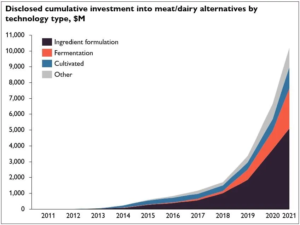The global dairy industry is on the brink of a transformation, driven by innovative technologies like precision fermentation. Recent developments, such as the establishment of the world’s largest precision fermentation plant by Remilk in Kalundborg, Denmark, underscore the potential of this technology to disrupt traditional dairy production. This center is established in more than 750,000 square feet and will produce non-animal dairy protein for use in products like cheese, yogurt, and ice cream; in volumes equivalent to that produced by 50,000 cows each year. Considering 10000 Litres per annum of milk production per cow with 65% of them in milk; this plant will have a capacity to produce 1 millions litres per day equivalent to milk proteins. In this article, we delve into the impact of precision fermentation on the dairy sector, particularly in the context of India’s evolving dairy industry.

“Kuldeep Sharma- Founder Suruchi Dairy Advisor”
Precision Fermentation at global level
Precision fermentation represents a paradigm shift in dairy production. Unlike traditional methods reliant on animal agriculture, precision fermentation leverages microbial hosts to produce specific functional ingredients, such as dairy proteins, enzymes, and flavoring agents. Companies like Perfect Day, Clara Foods, and Impossible Foods have demonstrated the viability of precision fermentation in creating dairy alternatives that are indistinguishable from traditional products.
Global dairy demand and sustainability
The escalating global demand for dairy products poses significant challenges in terms of sustainability, animal welfare, and environmental impact. The traditional dairy industry contributes to greenhouse gas emissions, freshwater depletion, and ethical concerns related to livestock farming practices. Precision fermentation offers a sustainable solution by reducing reliance on animal agriculture, mitigating environmental damage, and addressing ethical considerations.
Could Minimum Global milk demand be met without cows ?
In order to fond the answers we carried out a brief research. First we looked at the total demand of milk in the world . We applied the 250 ml per capita paradigm by WHO on the population list of 232 countries in the world. We found some very interesting insights which could be seen in the following table. While the top 9 countries requires a minimum of 1.1 Billion litres of milk per day; the bottom 100 countries require 21 million litres of milk. The bottom 50 countries demand 1 million litres of milk per day only.

Suruchi Research estimates that around 2000 such establishments as that by Remilk are capable of handling the minimum milk demand of the globe without a single cow. Doesn’t it look plausible now ? I leave the answers to all the experts around who have been ignoring this intervention and not acknowledging it as a threat to the dairy sector.
Opportunities and challenges in the Indian Dairy Industry
India’s dairy industry, characterized by prominent cooperatives like Products of Amul, faces both opportunities and challenges. The sector plays a crucial role in the country’s agricultural landscape, yet it grapples with issues such as cow diseases (like FMD, Bruceloosis, Lumpy skin disease, etc) in various regions, carbon emissions from dairies, and the need for sustainable practices. The emergence of precision fermentation presents a pathway towards sustainable dairy production, aligning with initiatives aimed at doubling farmers’ income and promoting environmental stewardship.
Precision Fermentation Startups in India
The momentum of precision fermentation is palpable in India, with a growing number of startups entering the space. Initiatives like the Humane Entrepreneurship Program, led by organizations such as Humane Society International/India, showcase innovative solutions ranging from lab-generated tissue for cosmetic testing to plant-based dairy and meat alternatives. Startups like BioDimension Technology, Phyx44, ProMeat, Naya M!lk, Ethik, and Plantish Foods are at the forefront of this technological revolution.
The way forward
We could see this small group of bio-engineering-enthusiasts building a better world for the coming generations in India too. I won’t be surprised to relish lab made cheese, paneer, protein shakes, greek yogurts, widely available in Indian-markets by 2025-26.
It is projected that by 2030, 50% of auto sales in India will be of electric vehicles. The disruption in food also is likely to follow the same trajectory.
As per the findings in a report by Rethinkx “By 2030, demand for cow products will have fallen by 70%. Before we reach this point, the U.S. cattle industry will be effectively bankrupt. By 2035, demand for cow products will have shrunk by 80% to 90%. The cost of modern foods and other precision fermentation products will be 50%-80% lower than the animal products they replace; which will translate into substantially lower prices and increased disposable incomes. “
This is the right-time for the experts and think-tank of our country to assess the future-scenarios linked to these disruptions. Underestimating these disruptions today may cost too much tomorrow.
Investment and Technologies
There has been huge investments in precision fermentation projects in the past few years. Protein alternative companies raised $530 million in disclosed investment in 2018. In the space of one year this investment increased more than three-fold to $1.66 billion. Despite a global pandemic and financial uncertainty, confidence in protein alternative start-ups was resilient. Surprisingly investment in both 2020 and 2021 in this sector exceeded $3 billion. Historically, ingredient formulation has been the key focus for investors; with these businesses receiving more capital than any other category of food technology. Ingredient formulation describes the blend of proteins (e.g. soy, wheat and pea) . Alongside other plant-based ingredients to form a final meat or dairy alternative product are also used. Here, development chefs play a significant role in the success of the product.

Environmental Imperatives and Economic Opportunities
Environmental imperatives such as reducing greenhouse gas emissions, conserving freshwater resources, and promoting ethical practices in food production are driving the shift towards precision fermentation. Moreover, the economic potential of precision fermentation is substantial, with investment in the sector surpassing billions of dollars globally. Ingredient formulation, product development, and market adoption are key focus areas driving the growth of precision fermentation technologies.
Future Projections and Impacts
Projections suggest that precision fermentation will have a transformative impact on the dairy industry. We expect a significant decline in cow product demand by 2030, which will lead to lower prices and increased affordability of precision fermentation products. This trend aligns with broader shifts towards sustainability and innovation in food systems, mirroring developments such as the rise of electric vehicles in India’s automotive sector.
Conclusion
The rise of precision fermentation stands as a transformative force in the dairy industry, heralding a new era of sustainable and innovative production methods. With Remilk’s groundbreaking plant in Denmark and a surge of investment in precision fermentation projects globally, the potential to disrupt traditional dairy production has become increasingly tangible.
As we navigate the complexities of global milk demand, environmental imperatives, and the evolution of the Indian dairy industry, precision fermentation emerges as a beacon of hope. Startups and initiatives like those highlighted by Humane Society International/India showcase the diversity and ingenuity driving this technological revolution.
Looking ahead, Dairynews7x7 serves as a vital platform for staying abreast of the latest developments, trends, and insights in the dairy sector. The convergence of environmental consciousness, economic opportunities, and technological advancements underscores the imperative for stakeholders to embrace and adapt to the changing landscape.














